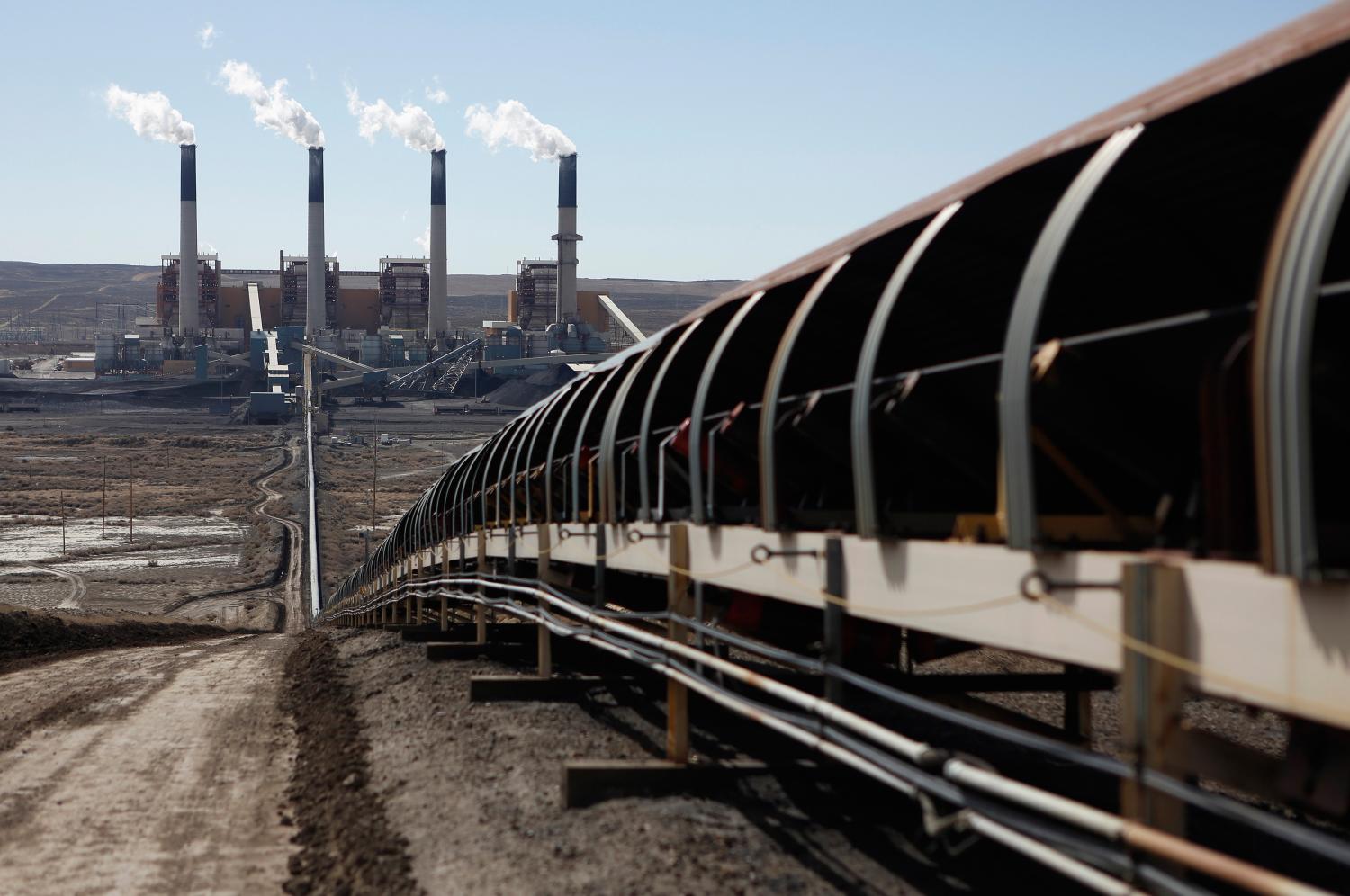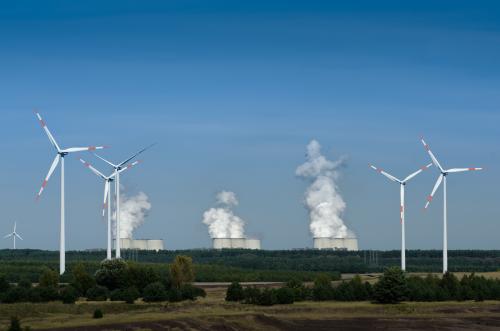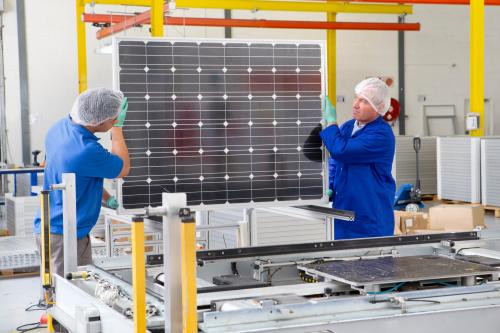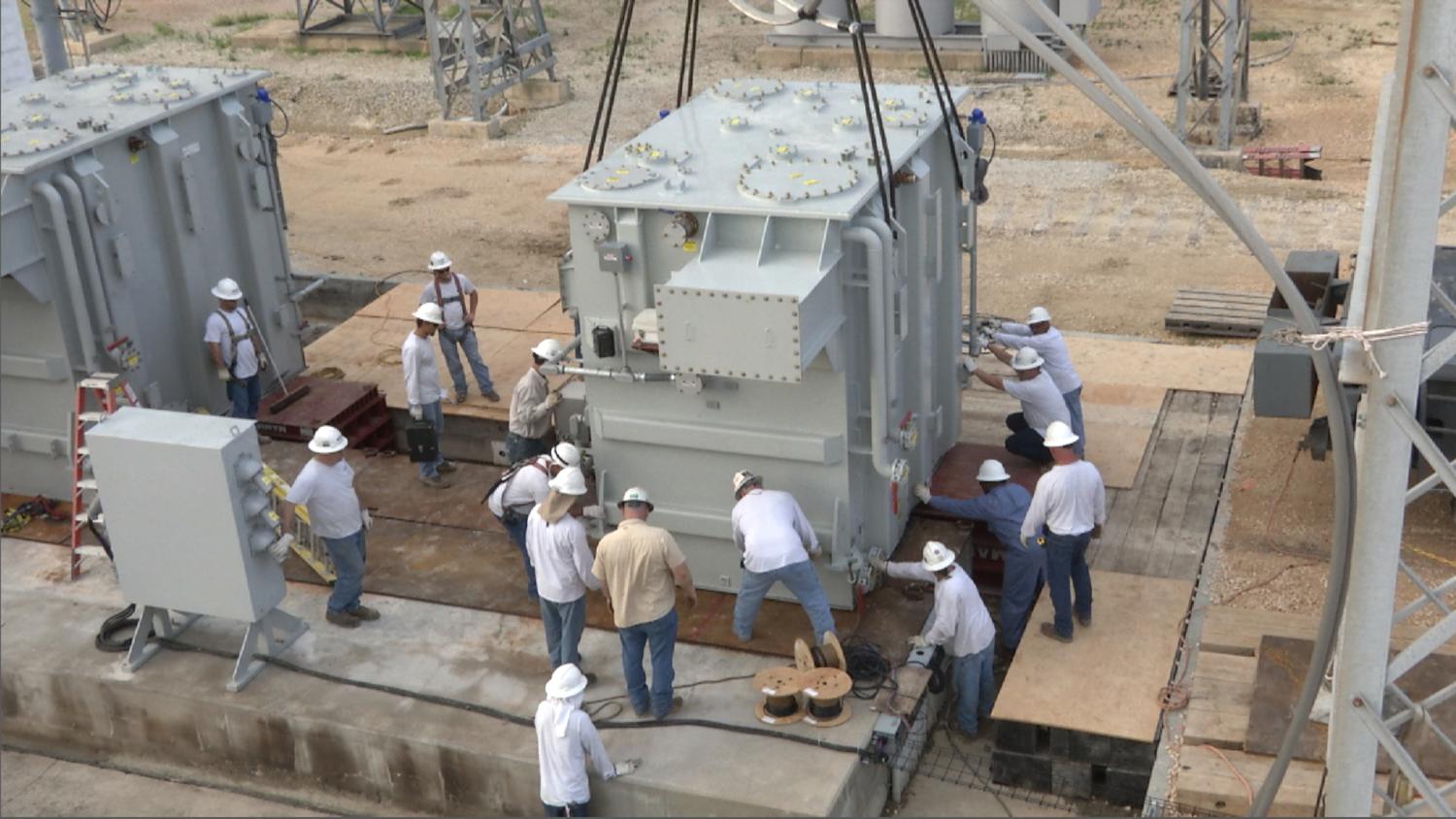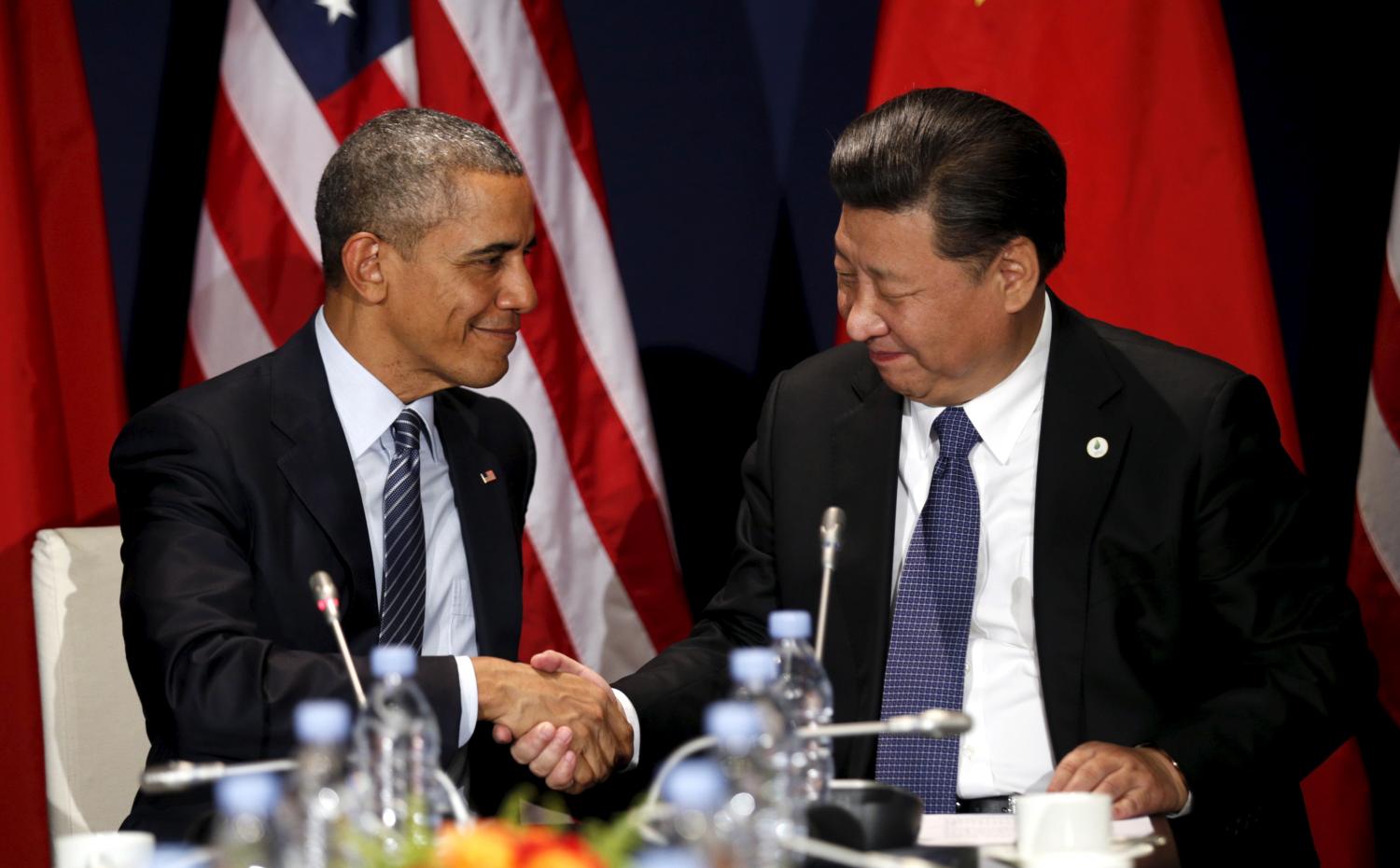The following brief is part of Brookings Big Ideas for America—an institution-wide initiative in which Brookings scholars have identified the biggest issues facing the country and provide ideas for how to address them. (Updated January 24, 2017)
Improving Energy Infrastructure
Physically, the energy system of the United States—which is typical of an advanced economy—is divided roughly into thirds. One portion of primary energy goes into transportation, which is dominated by oil—a prized fuel because it is a liquid at most relevant temperatures, has high power density, and is relatively cheap. Those attributes are crucial for mobile transportation that must carry its own energy supply. A second portion (about two-fifths) is transformed into electric power before being consumed in the economy; in power, there are many different sources of primary energy that compete effectively. The rest is utilized in a variety of stationary sources, such as for heating homes and providing process heat in factories—uses that are dominated by natural gas because in North America natural gas is quite cheap, thanks to huge new supplies from shale gas. Figure 17.1 summarizes the picture.

The overall picture in figure 17.1 changes slowly because the sheer size of energy infrastructures—such as oil and gas pipelines, roads, and electric power networks—impedes change. A costly, interconnected capital stock creates lock-in effects that slow down the rate at which evolution is possible. Nearly all the grand challenges in energy policy require fundamental transformations in energy systems. Yet such transformations are slow and difficult to steer with policy. Historically, whole energy infrastructures need about 50 to 70 years for such transformations, although with active policies perhaps change could unfold faster in the future.1
Stopping climate change quickly—so that, for example, the United States and other nations can meet the bold goals they set in the Paris Agreement to stop warming at well below two degrees higher than preindustrial levels—would require transforming the energy system over about three decades, or twice the historical rate of turnover. Very few societies have ever done that, and pushing the energy system so quickly creates a high risk for economically and politically costly errors.
Over the last four decades—since the Arab oil embargo (1973–74)—the United States, like most other advanced economies, has made a huge shift toward the use of markets instead of direct regulation in governing the production and use of major fuels. Today there are global markets for oil; even though much oil still comes from dangerous and unreliable places in the world, global sourcing and efficient markets help make oil supplies more secure. A global market for gas is also emerging, and there is some global trade in coal. Within the country, all of these fuels trade in reasonably well-managed markets. The mission of creating efficient markets for primary fuels has been achieved.
Attention is now turning to how these fuels are transformed into useful services—in particular, electric power. Most studies suggest that the process of electrification of the economy—that is, the conversion of primary energy into electricity before it is used—will continue, especially if there are major efforts to cut pollution of all types. Even the area that has long been thought to be most difficult to electrify—transportation—is now seeing some inroads thanks to electric vehicles.
Because electricity is essentially impossible to move between continents, these markets are nearly always national and regional affairs. While the United States has three large grids, the interconnections within those grids are generally weak; thus, for practical purposes, the relevant size for U.S. power grids is even smaller and the role for state-level policy greater. This creates the central challenge for federal policy on electricity. The country overall stands to gain a lot from greater use of well-designed electric power systems, but the leverage available to the federal government is highly indirect. The Federal Energy Regulatory Commission (FERC) has jurisdiction over interstate power transmission and over markets broadly, but it cannot dictate many policies to the states.
Incorporating Renewable Energy
A smart policy strategy around electricity must focus on places where the federal government has leverage. This administration should focus, in particular, on what is emerging as the central challenge for electric power: supporting growth in renewable energy while reconciling its inherent variability. There is a solid bipartisan consensus on the value of increasing use of renewable power—mainly solar and wind. That agreement across Republicans and Democrats is reflected, for example, in large, ongoing federal tax credits for renewable power as well as policies that actively require renewable power in 29 states.2 Because new renewables get subsidies, advocates for other energy sources—such as hydropower, biomass, and, now, nuclear—are also seeking and obtaining subsidies. These many different subsidies are creating growing distortions in power markets—as evident, for example, in states such as Texas and Illinois where power markets with large amounts of subsidized supplies of wind power drive power prices negative at times. In such settings, base load power supplies—that is, gas, coal, and nuclear—cannot compete. This approach to power markets is unsustainable and is poised to have large, adverse, system-wide impacts such as the loss of large amounts of zero-emission nuclear power.
The new administration could usefully focus on three challenges for power grids laden with renewables. First is unwinding today’s complicated and distortionary subsidy regime. There has been a compelling logic for subsidizing new energy sources—to promote innovation and commercialization—but for standard renewable power sources, those innovation goals have already been achieved. The opportunity to begin this unwinding will come with larger overhauls of tax and budget policies of the country. Subsidies for production of mature technologies should be scaled back while investment in fundamental pre-market innovation through research and development (R&D) should be scaled up. Compared with the size of the challenges the country faces in energy and the need for advanced technology to solve them, the United States massively underinvests—perhaps by a factor of two or three—in public sector R&D. While it is politically popular to bash examples of failures from past R&D investments—failures that are intrinsic to any portfolio of investments in untested ideas and technologies—the reality is that the track record for energy-related R&D spending is generally excellent.
A second challenge—where R&D support as well as demonstration projects and market reforms could be pivotal—relates to integrating these renewable energy supplies into the grid. Parts of the United States are moving quickly to power grids that rely on large amounts of renewable power—California and New York have adopted laws to require 50 percent renewables by 2030, while Hawaii aims for 100 percent by 2045. A particularly high priority for the incoming president is to offer strategic guidance that can help states—starting with the states that are rapidly moving to renewables and soon other states as well—integrate renewables into the grid without undermining other goals, such as deep cuts in emissions and reliability. While this administration will disagree with these state governments on many topics, this is an area for useful common ground.
A third challenge relates to transmission infrastructure. Large integrated grids are usually better able to smooth out variations in pockets of supply and demand since those variations tend not to be correlated across large geographical areas. The incoming administration has signaled its interest in boosting investment in infrastructure. That effort, which seems to have focused mainly on roads and airports and other areas, should expand to include the power grid—and to building the elements of what could become a truly national grid system, such as exists in China. It should also engage with the need for massive investment in storage of power. So far, the federal government has played almost no role in the debate over storage, but the FERC should focus on potential needs for interstate storage projects that will need to integrate with bulk trade in renewable power. Grids that rely mainly on renewables will need multiday storage capabilities if electric power service is to be reliable.3
Securing the Power Grid
In tandem with helping the nation make its power grids more capable of handling large amounts of renewable power, security of the grid will rise in importance. Much in modern society hinges on grid supply. After Superstorm Sandy hit the Northeast, for example, it proved extremely difficult to restore order and basic services in part because the failure of traffic lights had snarled the roadways.4 Absent electric service, water and sewage services were shut down, public transport was largely unavailable, and electric gasoline pumps did not operate. The threats to the grid include nature and, perhaps increasingly, malicious attack. And the control systems on the grid may be vulnerable to cyberattack, as happened on parts of the Ukraine grid in late December 2015 through a skilled penetration that appeared to originate from Russian hackers.
The challenge for hardening the grid is not with small failures—such as those triggered by tornadoes or hurricanes or the errant foot of an unfortunate squirrel. Those happen regularly and the industry is extremely good at planning and responding to such knowable interruptions in service. Large-scale and long-duration outages are a different story because they are harder to predict and require a different form of preparedness. They require a more active program at the Department of Energy (DOE) to demonstrate technologies that can improve resilience to power loss. And they require the Department of Homeland Security (DHS) to lead a much more rigorous effort at regional planning for the impacts and recovery from long-duration grid failures.
These are the central, new challenges for the electricity supply and distribution system. The federal government must also stay abreast of many other issues related to energy supply and marketing. These include, for example, modernization of the management of the nation’s strategic oil reserve—an anachronism left from an earlier era where government action had a larger impact on oil supply. Fuel economy standards for vehicles also need monitoring, but the Obama administration has already done extensive work in this area and the regime is in good shape for now. Some political forces will want to roll back those standards, but the automakers are already responding to existing rules, and little more of significance can be done in the next four years. Challenges include the economic impacts of energy production and utilization—including in sectors that are declining, notably coal. It is essentially impossible to rebuild the coal industry to its earlier status, but helping workers manage the transition to new jobs is important. The federal government will also be asked to help rethink the nuclear power industry, which is in the midst of a massive effort to make itself more competitive. Losing a large fraction of the existing U.S. nuclear fleet could be extremely harmful, not least to the nation’s efforts to control emissions and provide diversity in power supply. In some areas, new legislation could help—such as efforts to adopt a rational long-term strategy for interim and then final storage of the spent nuclear fuel that is accumulating at the nation’s reactor sites. Regulatory streamlining could also help. But most of the needed actions are within the industry, with the power markets, and at the state level—such as in Illinois and New York where state legislatures are being asked to help financially ailing local plants.
Environmental Regulation and Climate Change
It will be tempting for Republicans, who have unified control of the presidency and Congress, to use this power to roll back many Obama-era and earlier environmental regulations, including national as well as international policies on climate change. That effort would be a mistake, but if it proves necessary politically, then it should be organized in a way that minimizes harm to U.S. foreign policy and business interests.
On environmental regulation generally, the period since the election has seen many plans for rolling back Obama-era rules. Caution is needed: many of those rules are already far along in implementation and rollbacks will create regulatory turmoil that is harmful to business investment. Rules on methane emissions from fracking, for example, are already being implemented in important producing states (indeed, those state rules were the model for the federal rules), and industry already knows it must manage these emissions. The Clean Power Plan offers a similar context where too much regulatory gyration would actually harm the interests the new administration says it wants to advance.
On climate, temptations to roll back the Paris Agreement are many. But it is important to take a sober look at how this agreement actually reflects and advances American interests. The United States played a central role in creating the Paris Agreement and making it much more flexible than the approach favored by the European Union and other important actors. Notably, the United States and China worked bilaterally to set the tone for the Paris talks and continue to cooperate on energy research and related topics.5 Even as the United States and China face difficulties in their relationship elsewhere, this bilateral cooperation remains possibly the most effective example of what they can do together. The architecture of the Paris Agreement—which relies on countries to set their own commitments flexibly through a “bottom-up” process—largely mirrors U.S. and Chinese interests.6 The United States has also developed a similar bilateral cooperation on climate and energy with India, although that process is less advanced. The United States has a strong interest in continuing to shape this process.
If the new administration aims to withdraw from United Nations cooperation on climate change, it should do it in a way that minimizes the inevitable harm to the U.S. reputation and foreign policy strategy. One model is that of the George W. Bush administration, which refused to ratify the Kyoto Protocol (and earned international scorn) but then slowly built up parallel efforts with a smaller number of countries, mainly in Asia. One area of immediate importance is to work with countries to review national policies to learn what is actually working (and at what cost). Such a review mechanism is envisioned under the Paris Agreement, and a constructive role for the new administration would be to participate with important countries—including China and India—in demonstrating how these systems work, just as the country has done bilaterally with China under the Group of Twenty (G-20), where countries self-volunteered for reviews of their national efforts to cut energy subsidies.7 If the United States withdraws from the Paris process—either legally or de facto—then it should expect that other countries, notably China, will fill the vacuum in ways that could harm U.S. interests. Formal legal withdrawal from Paris would be the worst of many options—a softer withdrawal and shift in focus to other forums would be much more constructive.
Conclusions and Predictions
The central challenges in energy policy have radically changed since the oil crises of the 1970s. As oil problems have waned, much more energy attention has shifted to electricity.
Making the federal government relevant to the process of electrification requires a strategy and a focus. Here, I’ve suggested three: making markets work, making infrastructure secure, and tackling climate change. Within each are some high-priority items—such as funding for R&D—and nearly all of the priority items will require that Congress and the administration work together to change laws and appropriate funds.
The most likely prediction for energy policy in the upcoming administration is that much of the real policy action will reside within the states. At the federal level, many of the most visible initiatives and disputes will likely be about symbolic policies—areas where policy action is relatively easy to organize and where decisions pretend to offer serious solutions to hard problems. There will be initiatives to promote renewables but persistent failures to build the grids and markets needed to integrate them reliably.
When the politics of serious energy policy become impossible to manage, then a torrent of symbolic actions fills the space. The biggest challenge for the next administration may be to manage the symbolic moves needed to placate organized interest groups while guiding the federal government toward a more rational and strategic approach.
Acknowledgments: A special thanks to Tim Boersma, Charley Ebinger, Bruce Jones, Mark Muro, Michael O’Hanlon, Ric Redman, Janet Walker, and Philip Wallach for comments on a draft and to Jen Potvin for research assistance.
-
Footnotes
- Bill Gates, “A Rational Look at Energy,” GatesNotes (blog), October 13, 2010, www.gatesnotes.com/Books/A-Rational-Look-at-Energy-Energy-Myths-and-Realities; Kingsmill Bond, “The New Energy Transition: History Is Bunk,” Trusted Sources, September 5, 2016, www.trustedsources.co.uk/new-energy/energy-demand/the-new-energy-transition-history-is-bun.
- “State Renewable Portfolio Standards and Goals,” National Conference of State Legislators, July 27, 2016, www.ncsl.org/research/energy/renewable-portfolio-standards.aspx.
- Bryan Pivovar, “H2 at Scale: Deeply Decarbonizing Our Energy System,” National Renewable Energy Laboratory, April 4, 2016, www.nrel.gov/docs/fy16osti/66246.pdf; Renewable Electricity Generation and Storage Technologies, vol. 2, report NREL/TP-6A20-52409-2 (National Renewable Energy Laboratory, June 2012), www.nrel.gov/docs/fy12osti/52409-2.pdf.
- Stephen Lacey, “Resiliency: How Superstorm Sandy Changed America’s Grid,” Green Tech Media, June 10, 2014, www.greentechmedia.com/articles/featured/resiliency-how-superstorm-sandy-changed-americas-grid.
- David G. Victor, “The US-China Climate Deal Is a Model for World Diplomacy: Too Small to Fail,” The Guardian, November 13, 2014, www.theguardian.com/commentisfree/2014/nov/13/us-china-climate-deal-diplomacy-paris.
- David Victor, “Why Paris Worked: A Different Approach to Climate Diplomacy,” Yale Environment 360, December 15, 2015, http://e360.yale.edu/feature/why_paris_worked_a_different_approach_to_climate_diplomacy/2940/.
- The United States’ Efforts to Phase Out and Rationalise Its Inefficient Fossil-Fuel Subsidies, G-20, September 5, 2016 (www.g20.org/English/Documents/Current/201609/P020160919418466525465.pdf); China’s Efforts to Phase Out and Rationalise Its Inefficient Fossil-Fuel Subsidies, G-20, September 5, 2016, www.g20.org/English/Documents/Current/201609/P020160919413193754828.pdf.
The Brookings Institution is committed to quality, independence, and impact.
We are supported by a diverse array of funders. In line with our values and policies, each Brookings publication represents the sole views of its author(s).

